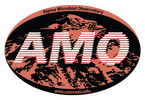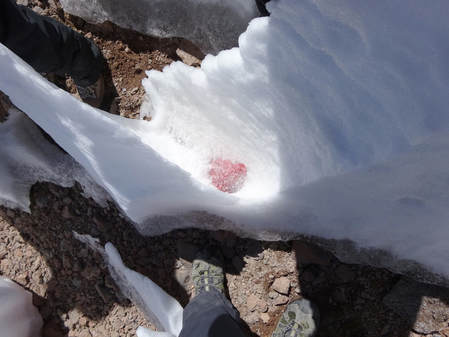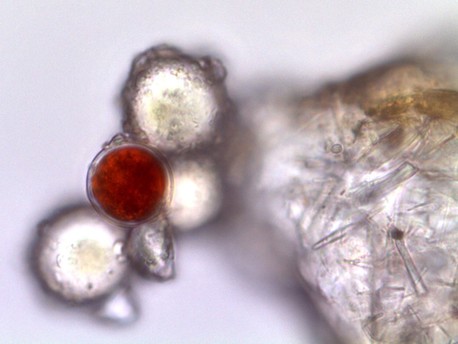|
by Adam Solon While hiking in the mountains you may come across snow that appears red or pink. This phenomenon, commonly called “red” or “watermelon” snow, is the result of microbial organisms known as algae. Algae inhabit a variety of environments – freshwater, saltwater, soil – and are single celled organisms that, like plants, use the sun for energy (photosynthesis). A particular type of algae, the snow algae, are capable of living in snow or ice during the melt season in alpine and polar environments across the Earth (Hoham and Duval, 2000). Our lab encountered them on the high, cold, windswept slopes of the Atacama Andes (Figure 1). As members of a large group of organisms known as green algae, snow algae have been to date mostly found within the genus Chlamydomonas or genus Cholormonas. Their brilliant red color is a response to the extreme cryospheric environments in which they are found (Figure. 2). In some known species of snow algae, the compound astaxanthin, a secondary metabolite known as a carotenoid, is responsible for the characteristic red pigment (Bidigare et al., 1993). The red pigmentation serves to limit exposure to the higher radiation found in high elevation and polar environments. This has a double effect of limiting cellular damage (Hagen et al., 1993) as well as alleviating major photoinhibition which is the disruption of energy production (Thomas and Duval, 1995). So, the next time you are out hiking and see some red snow realize there are a multitudes of those little critters hard at work surviving in the cold and painting an otherwise white landscape with a little color. References:
Bidigare, R. R., Ondrusek, M. E., Kennicutt, M. C., Iturriaga, R., Harvey, H. R., Hoham, R. W., & Macko, S. A. (1993). EVIDENCE A PHOTOPROTECTIVE FOR SECONDARY CAROTENOIDS OF SNOW ALGAE 1. Journal of Phycology, 29(4), 427-434. Hagen, C. H., Braune, W., & Greulich, F. (1993). Functional aspects of secondary carotenoids in Haematococcus lacustris [Girod] Rostafinski (Volvocales) IV. Protection from photodynamic damage. Journal of Photochemistry and Photobiology B: Biology, 20(2-3), 153-160. Hoham RW, Duval B (2001) Microbial ecology of snow and fresh-water ice with emphasis on snow algae. In Jones, H. G., Pomeroy, J. W., Walker, D. A., & Hoham, R. W. (Eds.). (2001). Snow ecology: an interdisciplinary examination of snow-covered ecosystems. Cambridge University Press. Thomas, W. H., & Duval, B. (1995). Sierra Nevada, California, USA, snow algae: snow albedo changes, algal-bacterial interrelationships, and ultraviolet radiation effects. Arctic and alpine research, 27(4), 389-399.
0 Comments
Leave a Reply. |
AuthorVarious lab members contribute to the MoM Blog Archives
October 2023
Categories |



 RSS Feed
RSS Feed
